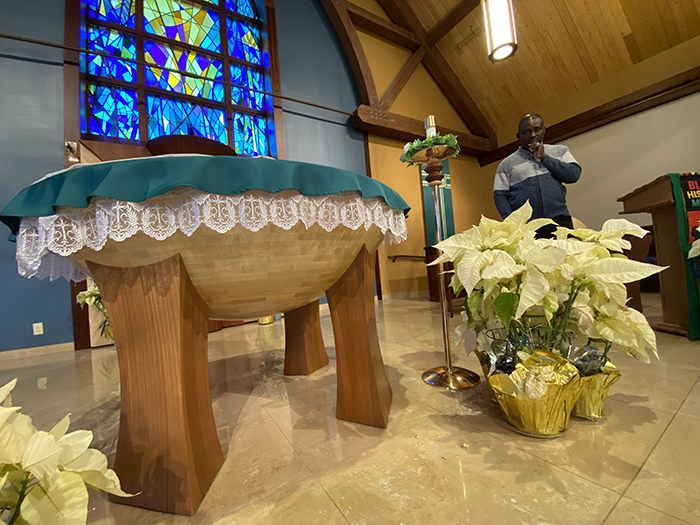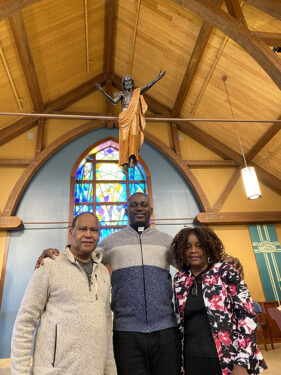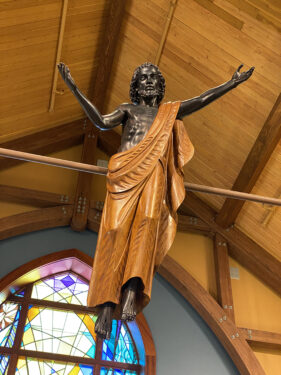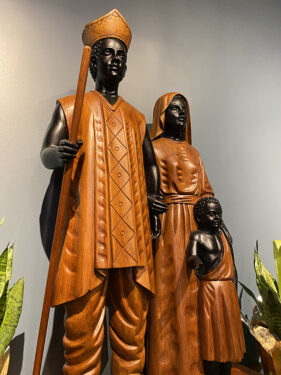

SPRINGFIELD GARDENS — The crucifix, positioned above the altar, is ubiquitous in Roman Catholic churches worldwide. But at one church in southeast Queens, it is the risen Christ with outstretched arms greeting all who enter.
His hands and feet show the wounds of spikes driven through them. But unlike how the image of Christ is usually depicted, at St. Mary Magdalene Parish in Springfield Gardens, he is black.
At the back of the church is a wooden statue of the Holy Family, with Jesus, Mary, and Joseph dressed in traditional African attire. They, too, are black, as is 85% of the parish, said Father Cosmas Nzeabalu, the parochial vicar.
These African-themed motifs highlight the church’s new building, which opened nearly seven years ago to replace one destroyed by an electrical fire. The original structure had served the neighborhood since the early 1900s when most area residents were Italian or Irish.
But in succeeding years, new immigrants arrived from West Africa and the Caribbean. With a “blank slate” to rebuild, parish officials decided to construct a worship space that represented the various heritages.
“It’s a very diversified parish,” said Marva Chevalier, the director of religious education. “You also have a growing Spanish population that is now coming in from Ecuador. And you do have African Americans born and bred here. You don’t want to leave them out.”

“And we do have a small group of Caucasians,” Chevalier added. “This makes us very multicultural in terms of how we approach the Mass. We can see growth taking place in the parish right now.”
Father Nzeabalu, for example, is from Nigeria. At the same time, parishioners come from Ghana, Cameroon, and various Caribbean nations, including Haiti, Jamaica, St. Lucia, Grenada, Trinidad, and Barbados.
“Many churches were built before Vatican II,” Father Nzeabalu said. “But since then, people are allowed to think about how to modify the church based on who they are. That’s the concept of inculturation. People are now allowed to experience Jesus from their own worldview.”
The rebuilding process began under the leadership of the parish’s previous administrator, Father Jeffry Dillon, who convened a committee, Chevalier said. She noted that Sister Maryellen Kane, then the parish life coordinator, helped drive the process.
“We had all different age groups involved,” Chevalier recalled. “And then the conversation became, ‘What would you like it to look like?’ So everyone had a say in it.”

The committee members subsequently signed off on designs that reflected the “ancestral heritages” of parishioners, said Chevalier, who is from Trinidad.
Father Nzeabalu added that the motifs are not from a specific African culture but appear in many countries, like the attire shown in the Holy Family statue.
Another fixture is a wooden statue of St. Martin de Porres (1579-1639), the lay brother from Peru who was born of a white father and black mother. Chevalier said his story of compassion and care for the sick and poor resonates with parishioners.
Also, the altar is not a traditional table but a huge wooden bowl.
“So, when you look at the altar, it is round,” Chevalier said, “because, for African families, the tradition was that you eat from one bowl — everybody shares.
“That’s what it looks like being here in the church,” Father Nzeabalu explained. “All of us come in as a family, and we partake in the Communion together, with one heart, one spirit, one soul.”
Father Nzeabalu also noted that the choice of the risen Jesus instead of the crucified Christ is a nod to the parish’s patroness, St. Mary Magdalene, who beheld Jesus on Easter morning.
“As she said, ‘I have seen the Lord,’ ” Father Nzeabalu said with a grin.
Meanwhile, St. Mary Magdalene’s leaders stand ready to accommodate all cultures. For example, if more congregants come from Central America, South America, or Mexico, the parish will respond with Mass in Spanish, Chevalier said.
“Because, you know,” Father Nzeabalu said, “it’s very open for everybody.”
